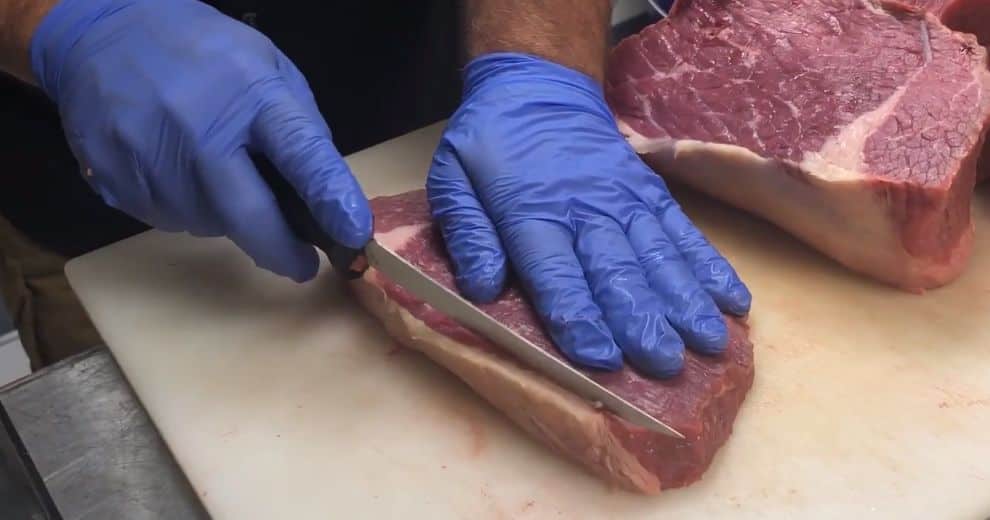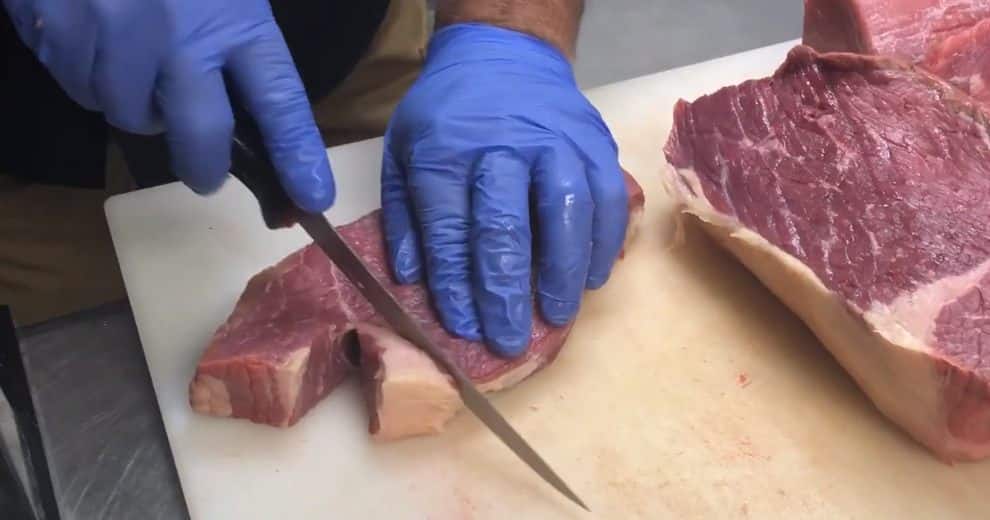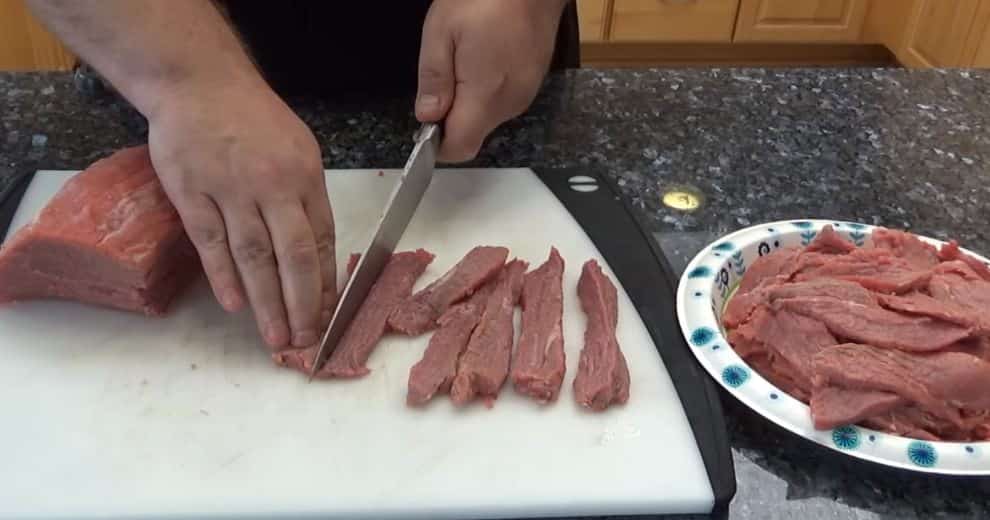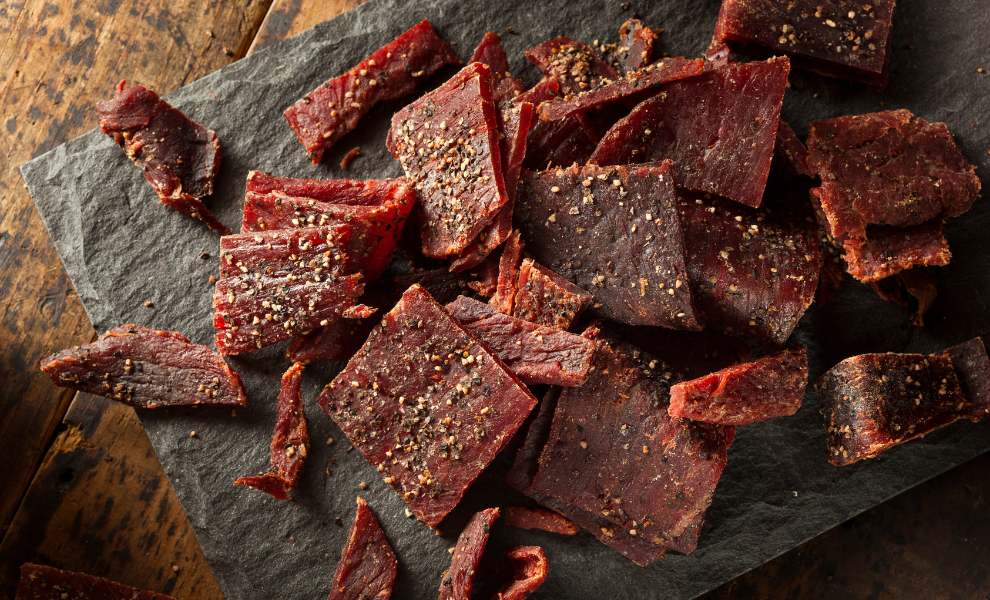Every product is independently reviewed and selected by our editors. If you buy something through our links, we may earn an affiliate commission at no extra cost to you.
Don’t you crave seeing the tempting spicy and juicy jerky on the food blogs or magazines? To entertain a small party or as a snack for camping or before TV on your favorite club’s exciting match, nothing can beat a bowl full of spicy jerky.
In the recipe of homemade jerky where beginners hesitate is slicing meat properly for jerky. And this very first step determines the texture and tenderness of the jerky.
In this article, I’m going to share how to slice meat for jerky and preserve it properly for making jerky at home.
How To Slice Meat For Jerky At Home
You won’t need many tools while cutting meat for homemade jerky. For slicing meat, you will need simple equipment like-
- Cutting board
- Sharp paring/boning knife or meat slicer
- Aluminum foil/plastic wrap to refrigerate the meat
Here I’m discussing the process step by step for your convenience.
Step 1: Collecting and Processing The Raw Meat: Before slicing the cut of meat, you have to process it in the following way.
You can get jerky from any cut of meat that has no bone in it. But for standard size jerky, collect a cut of beef round. Besides beef, you can take lamb, deer, or poultry.
Refrigerate the meat for up to 2 hours so that it becomes firm to allow you to cut uniform slices.
If you are using a cut of meat that has been frozen for a longer period, let it loose up a bit before cutting the slices.
Now it is time to trim the fat from your cut of meat to allow the jerky to be dried properly and last long.

- Place the cut of meat on a cutting board so that it remains stable while trimming the fat.
- With a sharp boning knife, cut the largest lump of fat around the surface of the meat.
- Then trim as much fat as you can.
- While doing so, place the other hand gently on the meat to get the balance.
- If you see a large chunk of fat on the meat’s inner surface, don’t hesitate to cut the meat at an angle and remove the fat.
- Do the same for the other surface of the meat.
- If there is a thinner or smaller chunk of meat, you can poke the tip of your knife into that area and pull out the fat.

Step 2: Finding The Grain: Before slicing the jerky pieces, look carefully if you are going to cut with the grain or against the grain.
If you cannot say it is just looking at the meat’s surface, you can cut a thin slice and see which direction the fibers have spread.
If you are not sure yet, grabbing hold of both ends, rip the thin slice apart. If you can do it easily, you are cutting against the grain.
And if it doesn’t rip apart easily, you are cutting with the grain. This part is really important as it will determine the softness/chewiness of your jerky.
Store them in your freezer until you are ready to cook them.
Step 3: Slicing The Meat in Uniform Thickness: Now with a sharp boning knife, you have to cut the jerky pieces. This part will be easy/a little difficult depending on the sharpness of your knife. Don’t pick a zig zag knife, as it will shred the meat.

Now start Slicing the meat into ¼”-3/16” thick pieces. If you are dealing with a large chunk of meat, first divide them into smaller portions.
Stabilizing the top of the cut, slice vertically, maintaining the same thickness.
To get more clarity watch this video –
- The direction of fibers will be in parallel or perpendicular with the knife.
- There is no hard and fast rule, how thick should the slices be, but try to cut them in uniform thickness. Thinner pieces will be dried quicker. To cook them in one batch, don’t make your slices larger than ¼ inch.
- Wear protective gloves while slicing the meat.
- Don’t cut the meat toward yourself.
- Refrigerate or freeze the slices until you’re ready to make jerky.
- The meat slices will shrink a bit in the dehydrator/smoker.
- So, try to maintain an ideal thickness so that they don’t turn into weird sizes after shrinking.
Also Read: How Do You Know When Beef Jerky Is Done Dehydrating
How To Slice Meat For Jerky Using Meat Slicer
Depending on their efficiency, a manual or electric meat slicer can slice .2 mm-1 inch thick pieces. Most of the meat slicers have an adjustable knob that will allow you to choose the jerky slices’ thickness.
All you have to do is that you will cut the cut of your meat in 1-1 ¼” slabs and feed it through the top funnel of the slicer.
If you are using a manual meat slicer, you just have to turn the handle a couple of times, and you will see nice, uniform slices coming out of the machine. Don’t forget to clean the meat slicer after using it.
In the case of the electric meat slicer, you have to just place your food on a sliding platform and push it towards a sharp rotating razor blade. If the blades of your meat slicer look dull, then sharpen the slicer blades before using them.
Just notice how you are dropping the meat chunk through the funnel-with the grain or against the grain in both cases.
How Thick Should You Slice Meat For Jerky
Well, there is no particular rule for this. It is all about your taste and preference. But you will see most professional jerky makers recommend ¼ inch thick slices for jerky. ¼ inch is the most popular option where many professionals choose 3/16 inch, which is also standard.
However, if you prefer a chewier jerky, you can slice your meat a little bit thicker. Again, if a tender and juicy batch of jerky is what you desire, you can reduce the thickness slightly.
However, a little bit more or less thickness than the standard sizes doesn’t matter. What matters is the slices should be of uniform thickness.
Also Read: Best Electric Knife For Cutting Frozen Meat (Top 6 Picks)
Avoid These Mistakes While Slicing Meat For Jerky
Slicing or processing jerky is concerned with handling raw meats which can be contaminated with pathogens (both from the source like beef, turkey, etc., or wild game like venison).
The pathogens can multiply quickly in a favorable environment and lead to serious illness if you don’t be careful while handling them.
Since jerky is not exposed to high heat cooking (only dried in the dehydrator), you have to be very cautious during the whole process from slicing to dehydrating and storing.
Especially in venison and other wild game cases, the raw meat must be cured before you slice and marinate it.
Avoid the following facts while slicing meat for jerky at home.
- Avoid any contamination while slicing. Before and after working with raw meat, don’t wash your hands just with water. Wash your hands properly with soap and water for at least 20 seconds.
- In case of a wild game, don’t forget to freeze the meat at 0ºF or below for 30 days.
- Don’t treat the meat as higher than this temperature range or for a shorter period.
- And don’t freeze up the meat in thicker slabs (more than 6 inches).
- Avoid making jerky of the wild game meat from an unskilled hunter. During the hunting, the meat can be contaminated with fecal coliform bacteria that should be exposed to only high heat cooking.
- Don’t leave the equipment and utensils for cleaning later. Clean them immediately.
- Don’t refrigerate the cut of meat more than 40ºF; otherwise, the bacteria won’t die.
- Don’t refrigerate ground beef for more than two days, red meats for more than 3-4 days.
- If you are busy or don’t have a plan of dehydrating the jerky within this time, freeze up until you can process it.
- Don’t let the frozen meat unfreeze outside. Keep it in the refrigerator.
- Don’t slice meat thicker than ¼ inch; otherwise, it won’t dehydrate properly and will be raw inside.
- Don’t choose a cut of fatty meat. Fat doesn’t have any enmity with the jerky taste (rather, it will increase the taste) but reduces its shelf life.
- Don’t leave any considerable amount of fat on the surface of your cut of meat; otherwise, it will spoil the jerky quickly.
- Keep the marinated meat in the refrigerator to set properly. Don’t marinate it outside the refrigerator.
- Don’t re-use the remaining marinade later on.
Also Read: How To Cut Frozen Ground Beef (7 Simple Ways)
What Is The Best Jerky Slicer For You
Though slicing the meat with a very sharp knife will do well, it is time-consuming to remove all the fat and get uniform-sized slices to get dried evenly at the same rate.
Though you spend enough time on it, it would not be possible to get even pieces if you are not a professional.
So, why take so much hassle when a meat slicer will do your job seamlessly?
When you have to make a large amount of jerky for business purposes or so, these meat slicers come as a blessing. This ingenious tool will turn a chunk of meat into uniformly thin slices.
Chef’s Choice Electric Meat Slicer is a lightweight and durable meat slicer for domestic use that will make the meat slicing much more effortless. Its removable cutting blade, food platform, deflector, and thickness guide plate are easy to clean.
Its powerful high torque motor will allow you to slice tougher meats. With the adjustable thickness guide plate, you can customize the thickness of your slices.
If you want to go for one with a lower budget, you can choose Elite Platinum EMT-503B Meat & Food Slicer without hesitation.
Its rust-proof cast aluminum body is made to last long. The retractable and removable 7.5-inch blade can slice almost any type of food.
With its adjustable thickness knob, you can switch to different thickness slices quickly. The extra-large slicing area is excellent for making large batches of slices.
What Are The Best Cuts Of Beef For Jerky
To say precisely, the cuts which have the least amount of fat in them are the best cuts for jerky. The most recommended cuts are lean beef round, flank, sirloin tip, brisket, chuck, and rump.
The eye of round, top round, and bottom round are the best choice for their minimal fat.
Among these, the eye of round (an oval muscle in the rear leg of a cow) is more popular for its least interior fat, tenderness, and price.
The bottom round (outer muscle of the upper rear leg) is another popular choice for jerky though it is not tender.
However, you can choose it for its lean shape, flavorful taste, and inexpensive price. The top round (from inside leg muscle) is another lean cut that is flavorful enough and less pricey. The tenderness of this cut is something in between the eye of the round and the bottom round.
The sirloin tip can be a great cut for jerky for its tenderness and very lean structure though it is not so popular (like the above) for its high price.
On the other hand, Flank steak is a challenging but lean, flavorful cut that will be great for tougher jerky but more pricey than the rest.
What Does Cutting With Or Against The Grain Mean
If you haven’t ever stepped into your kitchen before and don’t know what the “grain” of meat means actually, don’t worry.
The grain of meat means the direction in which the meat fibers have spread that you can easily notice within a meat cut. The fibers run parallel, and if you slice the meat in the direction of the fibers, that is called slicing/cutting with the grain.
On the other hand, if you slice the meat in the opposite direction of the muscle fiber, it is called cutting/slicing against/across the grain.
So, in short, when your knife cuts parallel with the grain, you are cutting with the grain. To do so, place the cut of meat before you in a way so that you can see the grains running vertically.
And when your knife is perpendicular to the grain, you are cutting against the grain.
Cutting With The Grain And Against The Grain-What Is The Difference
Slicing meat with or against the grain is the step where you can choose your jerky’s texture and tenderness. Cut with the grain when you want tougher and chewy jerky.
Since you won’t cut the meat fibers in this way, you have to bite and chew the fibers when you eat them.
As a result, the jerky will be harder to chew. For fishing trips, football/cricket matches on TV, your friends won’t mind this chewy jerky.
Slice across the grain when you are expecting softer jerky that is easier to tear apart and chew. In this case, your knife has already intersected the meat fibers, so your teeth won’t have to struggle with the fibers anymore.
Note: You can also slice the meat diagonally if you want to make something different. In this case, you won’t get uniform size slices.
What Meats Can I Use For Jerky?
You can use any lean meat for jerky-from beef, venison, lamb to turkey breast, etc. For its availability and flavor, most jerky lovers choose beef for their homemade jerky.
Deer meat or venison is another popular choice for jerky. Its lean shape, tenderness, and flavorful taste are the most favorite choice for many jerky lovers.
How Many Pounds Of Beef Will You Need To Make 1 Pound Of Jerky?
Beef jerky loses about half to one-third of its initial weight. If you prefer chewier jerky, that means if more moisture is taken out, the ratio of the weight of the raw meat and the final product can be up to 4:1.
Otherwise, you will need 2-3 pounds of meat on average to make 1 pound of jerky.
Is It Necessary To Slice The Meat In Uniform Pieces For Jerky?
Yes, the slices must be of the same thickness so that the whole batch of jerky dehydrates at the same rate.
However, it won’t affect the jerky quality, but you have to leave the thicker slices for some more time in the dehydrator to make sure that those pieces have dried properly.
What happens in these cases is- the outside of the thicker jerky dehydrates, and the inside remains raw.
Moreover, it is necessary to slice the meat in uniform pieces if you expect a consistent texture in the whole batch of jerky.
Because even if the thicker pieces have dried thoroughly, they will be of a far more different texture than the thinner ones.
How Long Does Homemade Jerky Last?
If you can follow some measures to store your homemade jerky, it can last up to 1-2 months after the initial packaging(in airtight packaging).
In Ziplock bags and the refrigerator, jerky will be okay for about one week or so.
But before that, you have to take all the moisture out, cool the jerky properly, store it quickly in a vacuum-sealed packaging or airtight container.
If you notice spots, furry texture, or unusual taste, throw the whole batch of jerky immediately.
Does The Butcher Slice Meat For Jerky?
If you don’t have a meat slicer and are having a hard time slicing meat for jerky, you can ask your local butchers for slicing the cut of meat.
If they have a commercial meat slicer, they can slice the meat for your jerky within a minute. It will save a lot of time and effort on your part.
Conclusion
Now, as you have known everything about collecting and slicing raw meat for jerky, half of your battle is won. So why don’t you dedicate this weekend and be the healthy snack sponsor for the next camping, family get-together, or fishing trip?

